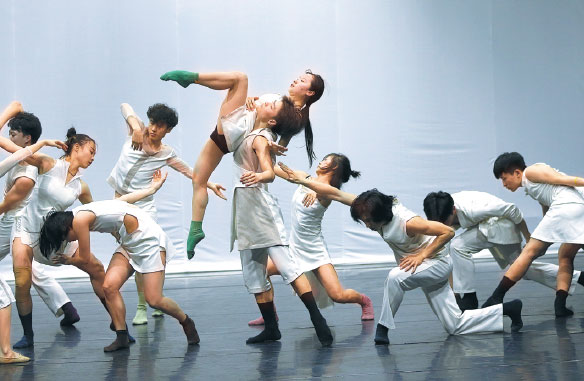Fusion form
Indian and Chinese artists get together to present a piece inspired by classical kathak and modern dance in Beijing, Chen Nan reports.
She spins around and around really fast with her long, black braided hair spinning in the air and her hands gesturing up and down.
"It's all about the center point. All the movements start and return to the center point of the body," gasps Mitul Sengupta, a 35-year-old Indian dancer-choreographer, who displays a movement of kathak, a major Indian classical dance form, at the theater of Beijing Dance/LDTX.
This is part of her latest choreography work, titled White Lotus - Black Sand, which will be staged at Beijing's Tianqiao Performing Arts Center on Friday and will travel to Taiyuan in Shanxi province on Monday.
The work is the first collaborative project between Rhythmosaic-Sengupta Dance Company, which was founded by Sengupta 10 years ago along with her husband, Ronnie Shambik Ghose, who graduated from the Hong Kong Academy for Performing Arts with a major in musical theater dance, and Beijing Dance/LDTX, which was founded by Willy Tsao in 2005.
Choreographed by the couple, Tsao and Ma Bo, the latter a veteran dancer of Beijing Dance/LDTX, White Lotus - Black Sand features more than 20 dancers from China and India. The music contains traditional instruments of both countries, such as the sitar and guqin (Chinese zither).
The costumes feature white and black not only to match the title of the work, but also to express the vibrancy of other colors through contrast, such as yellow and green, which was the idea of the participating Indian artists.
When it premiered at Calcutta Club, a well-known heritage venue in the Indian city of Kolkata, in December 2015, White Lotus - Black Sand was staged five times, drawing more than 5,000 people.
"The response of the audience was fantastic. This is a production to strengthen the bond and cultural heritage of the two ancient countries, which share lots of similarities and a long history of friendship," says Oindrilla Dutt, the curator and initiator of the project.
She named the dance work White Lotus - Black Sand to symbolize "peace, unity and the flowing of time".
Dutt, who is an experienced curator of the arts, got to know Sengupta and Ghose about a decade ago and offered them their first break onstage in India.
"Sengupta has had strong training in Indian classical dance from a very young age and Ghose has been trained in jazz, classical ballet and modern dance," Dutt says, adding that the couple are open to fusion of traditional and contemporary dance moves, which made their experiment with a Chinese modern dance company possible.
In 2014, Dutt came to Beijing along with the couple and dancers from the Rhythmosaic-Sengupta Dance Company to perform at the Beijing Dance Festival, an annual event launched by Tsao in 2008 to promote modern dance in the Chinese capital by bringing international contemporary dance troupes here as well as showcasing local talents.
According to Sengupta, it was her company's first trip to China and the first time for an Indian dance company to perform at the festival. The program they presented was titled Desolate - The Voices of the Trapped, which blends kathak with contemporary dance.
"We were impressed by the young Chinese dancers' techniques and along with Willy Tsao, we developed the idea of producing a dance piece to celebrate the diversity of both countries, which is based on the languages of kathak and contemporary dance forms," says Sengupta.
In 2009, Sengupta presented workshops at Nice University in France.
In 2012, the couple worked with French dancer-choreographer Gianin Loringett, giving a modern twist to Tchaikovsky's classic ballet, Swan Lake. Titled Swan Lake Revisited, the work was a fusion of classical ballet and kathak.
"Like technology keeps progressing, modern dance also develops fast, and one of the most important factors is to learn and be inspired from a different culture," says Tsao who runs three major modern dance companies in China.
"This collaboration opens our vision for modern dance. These artists showed us that Indian dance can be both very traditional and very modern."
Calling the experience both challenging and rewarding, Dutt says dance is universal, which is all about breaking down barriers.
"This is an exciting time to be an artist. In the past, there was a strong division of different forms of arts, but now artists can combine the arts together for independent expression," says Dutt.
Contact the writer at chennan@chinadaily.com.cn
If you go
8 pm, Friday. Tianqiao Performing Arts Center, 9 Tianqiao South Street, Xicheng district, Beijing. 400-635-3355.
7:30 pm, Sunday. Theater of Shanxi Vocational College of Art, 195 Bingzhou East Street, Taiyuan, Shanxi province. 0351-2246-059.
|
White Lotus-Black Sand is a collaborative production by the Rhythmosaic-Sengupta Dance Company and Beijing Dance/LDTX. |

























